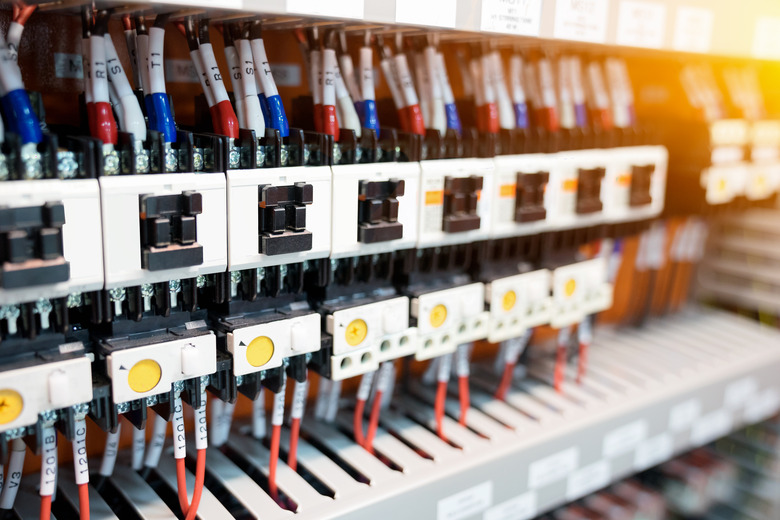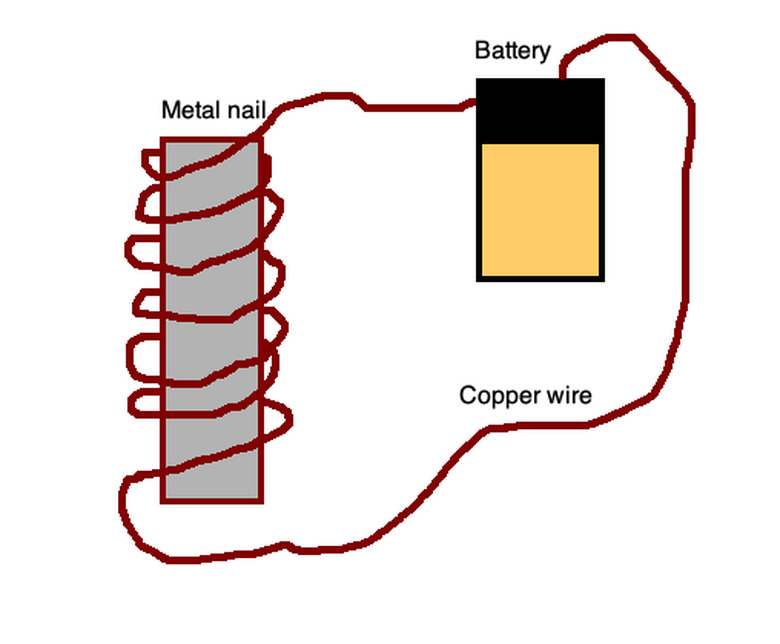What Are The Dangers Of Electromagnets?
Electromagnets are generally safe for their various uses, but you need to take precautions depending on the context in which you use them. Very, very powerful magnets and electromagnets that come into contact with or in close proximity to laptops or computers can damage their hard drives, but, for the most part, you don't have to worry about this.
The voltage, or electromotive force (emf), that results from the behavior of an electromagnet needs to be accounted for through techniques in physics and engineering to keep yourself and others safe. The current that flows through an electromagnet dictates how strong it is and, therefore, what sort of damage it may have to people and electronic devices. Take into account the emf danger levels of various uses of an electromagnet to remain safe.
Electromagnet vs. Magnet
Electromagnet vs. Magnet
While permanent magnets are magnetic no matter what the situation is, an electromagnet requires current sent through them to show electrical and magnetic properties such as field and force. Permanent magnets have chemical and physical compositions of atoms, alloys and other materials that allow charge to flow freely through them regardless of whether there is an electric current nearby and give off a magnetic field even in the absence of external current or field.
An electromagnet is generally made from coils of wires that act as a magnet when an electric current passes through them. Solenoids are devices of a thin coil of wire wrapped around a magnetic object that, when a current is sent through them, they will give off a magnetic field. In the above diagram, a metal nail inside a coiled copper wire can act as a solenoid that, when hooked up to a battery, gives off an electromagnetic field.
While the strength of permanent magnets depends on the type of material that makes them up, an electromagnet's strength depends on the amount of current that flows through it. Permanent magnets can lose their magnetic properties such as their ability to give off a magnetic field when they're heated to a certain temperature.
When demagnetized, they can be re-magnetized by changing their composition or placing them within a magnetic field of sufficient strength. An electromagnet, on the other hand, lose their magnetic capabilities in the absence of an electric current or electric field.
Electromagnets and Computers
Electromagnets and Computers
While it may be true that you have to keep powerful magnets away from computers to prevent damage to their hard drives, it's important to understand the exact role magnets play with respect to computers, especially given that computers are made of magnets. An electromagnet is generally safe near computers for these reasons.
Magnets don't delete things from hard drives because hard drives themselves are generally made with powerful magnets inside of them. If you leave a strong electromagnet close to a hard drive, it could cause damage to the hard drive, but this rarely happens.
Computer hard drives generally have two strong magnets made of neodymium, iron and boron that control their movements. This composition means that powerful magnets that come close to them will not be strong enough to penetrate the workings of the magnetic hard drive. Some other forms of memory, such as solid state memory, that computers use don't use magnetic fields. This means solid state hard drives won't be affected by magnetic fields.
The myth that magnets could cause harm to computers is rooted in the use of magnets to erase floppy disks. People began believing this meant any magnet can cause harm to computers. In actuality, you need a very strong magnet to cause such harm.
Electromagnet Strength
Electromagnet Strength
The cases in which hard drives to adversely affect computers have often involved very strong neodymium magnets being rubbed against the hard drive for about 30 seconds, but this is much more work than simply bringing a magnet in close proximity to a computer or laptop. Even then, these experiments have not shown that all data of a hard drive would be lost. They've only affected the top and bottom parts of the hard drive for the most part.
It's still generally best practice to not place powerful magnets in contact with computers for long periods of time. In any case, it's better to be safe than sorry or to make sure your technology and electronics are safe rather than putting them in unnecessary risk.
Electromagnets and Televisions
Electromagnets and Televisions
An electromagnet can affect monitors for computers or television sets. For classic cathode ray tube (CRT) television sets, powerful magnets can distort the images on the screen when they come close to them. This is because the magnets deflect the beam of electrons that the television sends to produce an image.
For more modern television sets, however, such as liquid crystal display (LCD) or light-emitting diode (LED) monitors, magnets don't affect their display or performance. LCD displays use backlight lamps with millions of pixels that are filled with liquid crystals that let the backlight through. LED monitors use red, blue and green light that can be polarized, or changed in direction, to produce images.
Electromagnets and Other Electronics
Electromagnets and Other Electronics
An electromagnet and permanent magnet wouldn't adversely affect SD cards and flash drives. These products don't depend on magnetic fields and forces as much as they would need to for magnets to damage them. Other technology such as cables can be affected if they aren't appropriately protected from external magnetic fields. Most cables are designed to prevent external magnetic fields from harming their use.
Even credit and debit cards can be harmed by magnets such that the cards may become unreadable. Magnets that change the distribution of iron oxide particles can cause this. You can prevent this from happening by keeping these cards with magnetic strips separated with at least one card in between them, keeping the cards out of intense heat exposure and using plastic or paper holders for the cards, rather than wallets or purses that rely on magnets.
Using Electromagnets Safely
Using Electromagnets Safely
Neodymium magnets should be packaged and handled appropriately so that they remain magnetized and able to respond to external magnetic fields for their specific purposes. An electromagnet with too much current flowing through it can become demagnetized due to the heat or energy that results from this.
People who ship magnets long distances or store them for different purposes need to make sure they use sturdy cardboard boxes with the magnets in the centers of them. This ensures the magnetic forces in the box don't damage anything external to their containers. For example, strong magnets may interfere with airport navigation controls when flying magnetic materials across long distances.
Building Devices With Electromagnets
Building Devices With Electromagnets
Make sure you're well aware of precautions you need to take when building devices such as electrical circuits, transformers or products involving heat and light. Generally, don't plug an electromagnet directly into battery sources or other sources of emf, but, instead, use plenty of copper wire to make sure an electromagnet has enough turns (or coils of the wire) to increase the resistance and prevent the emf from harming you.
Use the appropriate setup depending on the geometry of the electromagnet and circuit. For example, if the circuit consists of wrapping wires around a metal nail, make sure the wires are wrapped around in a way to keep the magnetic field uniform and distributed throughout to dissipate the emf appropriately.
Keep your electronic devices and circuits from overheating by paying close attention to the temperature of them. Continuously test how magnetic your devices are by using objects such as spoons or other steel objects. Change the current in slow, steady amounts instead of immediately switching back and forth between low and high amounts of current.
Experiment with different ways of building electromagnets such as solenoids so that you can conserve emf in the most efficient way possible and prevent extra emf from causing unnecessary harm.
Avoiding EMF Danger Levels
Avoiding EMF Danger Levels
Prevent children from playing with neodymium magnets. Swallowing magnets can cause serious internal damage to organs like the intestine and stomach, as the tissues of these organs can be pierced through the the sheer strength of the magnets' force.
Wear safety gloves when handling powerful magnets. Prevent magnets from hitting against one another. Make sure to preserve the magnetization and structure of the magnet by keeping it out of harm's reach.
If two magnets get stuck together, you can separate them by sliding one against the other in a sideways direction. Keep magnets away from other magnets to prevent them from damaging each other. These methods can help you avoid emf danger levels of electromagnets.
Electromagnets in Medical Technology
Electromagnets in Medical Technology
Consultant clinical scientist Lindsay Grant said magnets close to patients with pacemakers can adversely damage them. This means individuals with these artificial medical devices inside of them should be careful around powerful magnets and electromagnets activated with strong electric currents. The magnets that make up pacemakers need to respond to the heartbeat of patients, so external magnets can interfere with this.
Still, more research needs to be done to further understand how magnets closely affect technology in medicine. Devices and tools that biomedical engineers produce such as prosthetic limbs or metal plates implanted into parts of the body need to be thoroughly tested to make sure they meet their appropriate standards for their purposes while remaining safe. Environments that expose people to large magnetic fields need to warn individuals about whether they can have these engineered products.
Physicians Using Electromagnets
Physicians Using Electromagnets
As the use of electromagnetism spread through technology in medicine and medical research, scientists and physicians have raised their concerns about the safety of magnets and created preventative measures to protect human health. In these cases, the safety about human health, much more important than, for example, the safety of electronic products, means you should be extra careful when using magnets in a clinical setting.
In addition to the use of magnets in pacemakers in which magnetic objects are inserted in to the body, magnetic resonance imaging (MRI) uses strong magnetic fields (of about 1.5 tesla, which is over 20,000 times greater than the Earth's natural magnetic field) to create images of the internals organs and skeletal systems of patients.
The patients inside these powerful machines must make sure they're free from other magnetic materials so as not to interfere with the imaging process. These strong fields mean that other magnetic objects nearby can be affected so patients and physicians must be careful to protect themselves from them. As physicians use tools like hemostats, scissors, scalpels and syringes, these tools are generally very magnetic and should be kept away from the MRI scanners.
Other tools such as oxygen tanks and floor buffing machines are also very magnetic when used so they may pose threats when in close proximity to active MRI scanners. Engineers and scientists have developed sturdy non-magnetic versions of these medical instruments to address these issues. Other electronic devices like cell phones and watches that rely on magnets need to be held away from these scanners as well.
References
- MakeUseOf: Do You Need To Protect Your Computer From Magnets?
- UCSF Department of Radiology: Potential Hazards and Risks
- Sewell: Can Magnets Really Mess Up Your Computer?
- Adams Magnetic Products: Permanent Magnets vs Electromagnets
- Tech ARP: Hard Drive Myths Debunked Rev 5.4
- The nest: Why Do Magnets Ruin Credit Cards?
Cite This Article
MLA
Ather, S. Hussain. "What Are The Dangers Of Electromagnets?" sciencing.com, https://www.sciencing.com/dangers-electromagnets-5877042/. 8 September 2019.
APA
Ather, S. Hussain. (2019, September 8). What Are The Dangers Of Electromagnets?. sciencing.com. Retrieved from https://www.sciencing.com/dangers-electromagnets-5877042/
Chicago
Ather, S. Hussain. What Are The Dangers Of Electromagnets? last modified March 24, 2022. https://www.sciencing.com/dangers-electromagnets-5877042/

